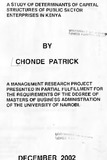| dc.description.abstract | Capital structure in all types of enterprises is important in influencing their
profitability and solvency. Many studies have been carried out on the
determinants of capital structure in the privately owned publicly quoted
companies all over the world. A lot is therefore known about the leverage of such
companies. However, very little is known about the capital structures and their
determinants in public enterprises controlled by the governments. It is therefore
possible that the capital structures of these enterprises may differ from those of
their counter parts in the private sector. Public sector enterprises play a
significant role in any country. In most cases they play dual role of social
(welfare) and commercial (profit).
This study aim at first of all determining what the capital structures of Kenyan
public sector enterprises are. Secondly, to find out the factors influencing the
capital structure.
The Kenyan public sector firms offer a unique opportunity of testing capital
structure theories. This is because most firms are not traded in the capital
markets and do not issue shares to the public. Thus the financing choice is
basically between internal funds and private loans.
This research studied fifteen public companies. Financial statements were used
for the period 1994-1998. The leverage levels and the significance of the
determinants of capital structure were investigated.
The results indicate that debt levels of public sector firms lie between 0-2.8 when
the debt to equity ratio is used and between 0 to 0.17 when measured by debt to
total assets ratio.
The study found out that profitability factor was the highest correlated with the
coefficient of 0.602. the other factors do not point to high correlation among the
explanatory variables such as: Non-tax shields is the least factor in influencing
leverage, it has a coefficient of -0.070. Assets structure -.220, size -.107, growth
.322, and liquidity -.275
The mean rate for public sector firms is .5051 in the combined run.
The study found that the finance and irivestments sector have the highest mean
ratio of debt to equity 0.99 followed by industrial and allied sector which has debt
to equity ratio of 0.76. The commercial and services sector has a debt to equity
ratio of 0.32 and the agricultural sector has debt to equity ratio of 0.03
The results obtained from using debt to total assets ratio, indicate that industrial
and allied firms have the highest debt to total assets ratio Of 0.21503, followed by
the commercial and services sector 0.086571, finance and investments sector
0.0536 and finally, the agricultural sector with the debt.
In a nutshell, it should be emphasized that in the public sector firms the other
qualitative factors do playa significant role in the determination of leverage ratios
of public sector enterprises. The qualitative factors that should be researched
upon include the Parent ministry aspect, legality and strategic considerations by
the government, composition of the Board of Directors just to mention a few. | en |

